Rotator Cuff Rehab Programs
Unconditioned, imbalanced muscles of the shoulder area can cause rotator cuff injuries. As the rotator cuff fatigues from excessive use, weakness, or lack of endurance, the ball of the shoulder joint becomes more mobile and moves upward. This causes the rotator cuff tendons to come in contact with bone, which can lead to irritation of the tendon, then inflammation and pain, then ultimately an injury (shoulder tendonitis, bursitis, impingement, etc.). Along with keeping the ball firmly in its socket, the rotator cuff has functions related to performance in sports. The rotator cuff provides power and control for the golf swing, tennis stroke, baseball/softball throw and pitch, volleyball serve and spike, and swimming.
The exercises described below are to help you strengthen the muscles in your shoulder (especially the muscles of the rotator cuff--the part that helps circular motion). These exercises should not cause you pain. If the exercise hurts, stop exercising. Start again with a lighter resistance.
RESISTANCE
The exercises described below are designed to improve endurance of the shoulder musculature, with strength gains being secondary. Therefore the emphasis is on controlled movement with low resistance and high repetitions. The use tubing is required for several of the exercises below with the others utilizing body weight or small dumbbells. . You should strive for perfect execution throughout your routine to help restore the proper movement patterns and reduce the symptoms in your shoulder.
FREQUENCY
Perform all the exercises 5 days per week, 1-2 times per day. Begin by performing 15 repetitions of each exercise for the first 3 days and then progressing to 2 sets of 15 repetitions. After 10 days progress yourself to performing 3 sets of 15 to 20 repetitions.
POSTURE
Perfect posture is one of the key elements in maintaining a healthy shoulder. Think of a skeleton hanging in a classroom. Its shoulders are naturally hanging back and down, giving it perfect posture and alignment. Unfortunately, most people have a tendency to slump forward, with their shoulder blades sliding forward and up. If you spend much of your day in front of a computer, as many Americans do, you’re probably slumping over, even if you’re not conscious of it. Keep your shoulder blades pulled back and down towards your waist, as if you’re thrusting your chest up. It is important to keep your shoulders in this position throughout the exercises and in life.
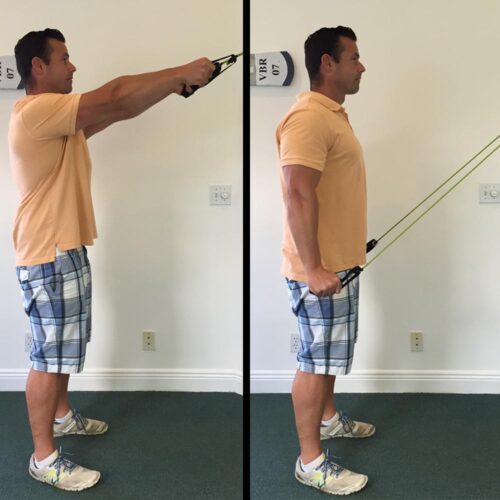
Rotator Cuff Pulldown
- Place the band above your head so you’re pulling it down at a 45 degree angle.
- Standing with great posture (shoulder blades pulled back and down towards your waist) grab the band with both hands, elbows straight, and thumbs pointing up.
- Pull the band down to your pockets and about 6-8 inches away from your body. Pause for 2 seconds in this position emphasizing a squeeze between your shoulder blades.
- Slowly return the band to the starting position.
- Repeat.
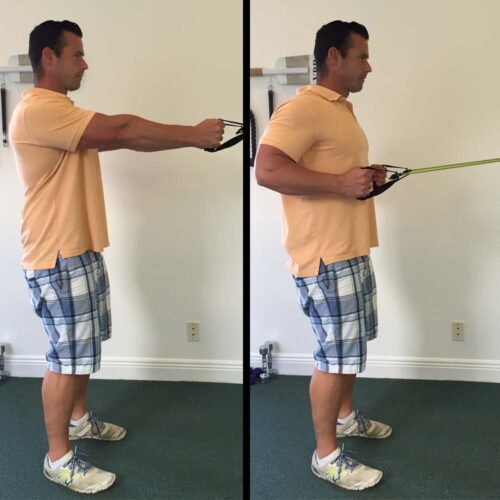
Rotator Cuff Standing Rows
- Place the band at mid sternum height so you are pulling in a straight line.
- Standing with great posture (shoulder blades pulled back and down towards your waist) grab the band with both hands, elbows slightly bent, and thumbs pointing up. Pull the band towards your chest by contracting your shoulder blades and bending your elbows.
- The finish position should have a great SBD, elbows bent at 90 degrees and located at mid torso.
- Hold that position for 2 seconds then return to the starting position.
- Repeat.

External Rotation
- Place the band at mid sternum height so you are pulling in a straight line.
- Standing with great posture (shoulder blades pulled back and down towards your waist), place your elbow at your side, bent at 90 degrees and gripping the band with the thumb pointed up. Hold a towel between your elbow and your side to you remind you to maintain this position.
- Your forearm begins by pointing across your body.
- Slowly rotate your shoulder out, keeping your elbow bent, and fixed to your side.
- Rotate out as far as possible by limits of motion or pain.
- Hold that position 2 seconds and slowly return to the starting position.
- Repeat.
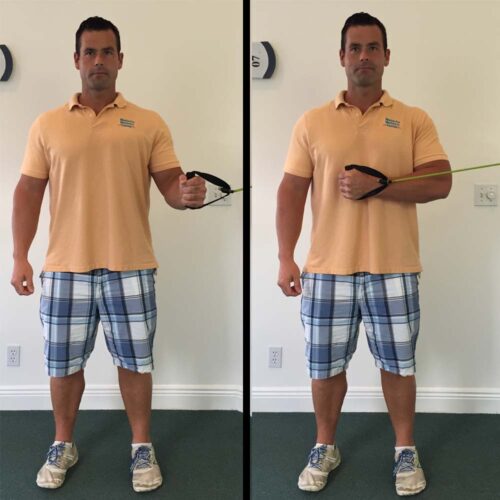
Internal Rotation
- Place the band at mid sternum height so you are pulling in a straight line.
- Standing with great posture (shoulder blades pulled back and down towards your waist), place your elbow at your side, bent at 90 degrees and gripping the band with the thumb pointed up. Hold a towel between your elbow and your side.
- Your forearm begins by pointing away from your body.
- Slowly rotate your shoulder in, keeping your elbow bent, and fixed to your side. Rotate in as far as possible by limits of motion or pain.
- Hold that position for 2 seconds and slowly return to the starting position.
- Repeat.
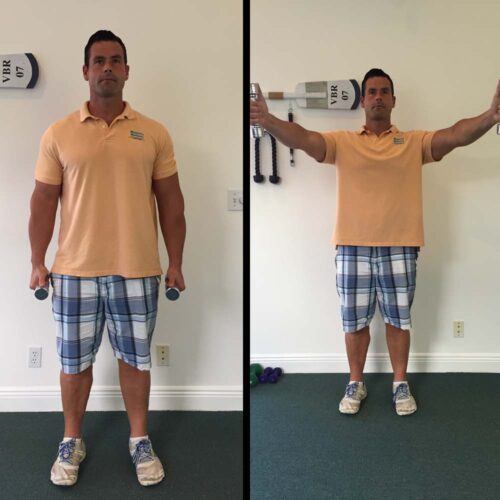
Standing Hitchhiker
- Stand with perfect posture (shoulder blades pulled back and down towards your waist) with hand placed on your thighs and your thumbs pointed upward.
- While gliding your shoulder blades back and down toward your waist raise your arms up at a 45 degree angle.
- Raise your arms to shoulder height only and keep your elbows straight.
- Hold this position for 2 seconds and slowly return to the starting position.
- Repeat.
- Begin this exercise with no resistance and gradually progress to 1-5lb dumbbells.
- Do not use weights heavier than 5lb.
- The smaller muscles of the rotator cuff are difficult to isolate using heavy weight.

Bicep Curl
- Stand with perfect posture (shoulder blades pulled back and down towards your waist).
- Keep your elbows next to your torso while holding a dumbbell or band.
- Initiate the movement by flexing your elbow and then slowly returning the starting position while maintaining good posture.
- Repeat.
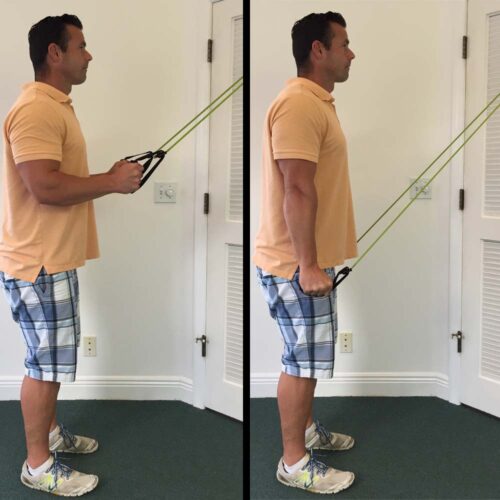
Tricep Press
- Begin the exercise with great posture (shoulder blades pulled back and down towards your waist), elbows by your side and bent to 90 degrees.
- Extend your elbows against resistance until you reach full extension.
- Hold this position for 2 seconds then slowly return to your starting position.
- Repeat.

Serratus Punch
- Stand with perfect posture (shoulder blades pulled back and down towards your waist), then grip the band firmly in your hands, sitting underneath your armpit, and your elbows bent to 90 degrees at your side.
- Extend your elbows forward until they are straight and then round your shoulders at the end of the movement.
- Hold this position for 2 seconds then slowly return to your starting position.
- Repeat.
CAUTION: If any of these exercises increases your shoulder pain, stop doing that exercise and contact your physician or physical therapist.
If you are interested in getting some more information on rotator cuff exercises, or on any other exercise or nutrition program, click here to contact us.
If you would like to download a pdf version of this program, click this link rotator cuff rehab exercise program.
